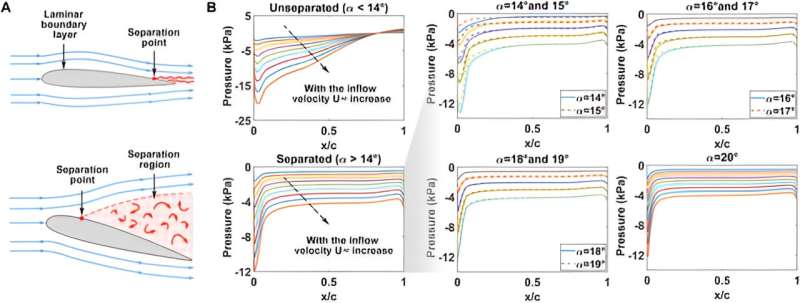This article has been reviewed according to Science X's editorial process and policies. Editors have highlighted the following attributes while ensuring the content's credibility:
fact-checked
trusted source
proofread
Investigating quantum computing and machine learning as effective tools in fluid dynamics

To prevent aircraft stalls, engineers have long studied the flow of air over airfoils such as airplane wings to detect the angles when flow separation occurs. Recently, a team of researchers at Shanghai Jiao Tong University, including Xi-Jun Yuan and Zi-Qiao Chen, investigated the use of quantum computing in connection with machine learning as a more accurate way of solving such problems.
The use of a quantum support vector machine rather than a classical support vector machine increased the accuracy of the classification of flow separation from 81.8% to 90.9% and increased the accuracy of the classification of the angle of attack from 67.0% to 79.0%.
These results help show that using quantum computing methods for fluid dynamics problems could be faster and more accurate than using classical computing methods, especially because the datasets in such contexts are large. Potential applications of quantum support vector machines in addition to aircraft design include underwater navigation and target tracking.
The researchers performed two classification tasks. The first was a binary classification on a small dataset to detect whether or not flow separation had occurred. A small dataset was chosen because it is difficult to achieve high-accuracy classification for small datasets.
Data for this task were collected from pressure sensors on an airfoil in a wind tunnel with different airspeeds and angles of attack. The dataset consists of 45 multidimensional points: 27 cases without flow separation and 18 cases with flow separation. This dataset was divided into 34 points for training and 11 points for testing.
The paper is published in the journal Intelligent Computing.

The second task was more complex. It classified the angle of attack of the airfoil after flow separation into one of four classes. To achieve this, the problem was broken into four one-against-all classification problems, with a binary in-or-out classifier for each of the four classes.
Data for this task were created by simulation. The dataset consists of 63 multidimensional points obtained by sampling. This dataset was divided into 43 points for training and 20 for testing. The training and testing process was repeated 10 times with different combinations of training and test data, and the average accuracy of 10 tests was obtained.
The particular type of classification algorithm chosen by the researchers is a quantum-annealing-based supervised machine learning algorithm called a support vector machine. The quantum annealer they used was the D-Wave Advantage 4.1 system, a physical quantum computing device.
Quantum annealing implementations of support vector machines have demonstrated better performance than their classical counterparts, which are structurally simple and robust but have high storage and computation costs and thus do not scale up easily.
Quantum annealing is an optimization process that uses quantum fluctuations to look for a global minimum among a set of solutions. Because the process generates multiple good candidates for the global minimum, it can achieve more accurate results than other optimization algorithms, which are more likely to get stuck at a local minimum.
More information: Xi-Jun Yuan et al, Quantum Support Vector Machines for Aerodynamic Classification, Intelligent Computing (2023). DOI: 10.34133/icomputing.0057















